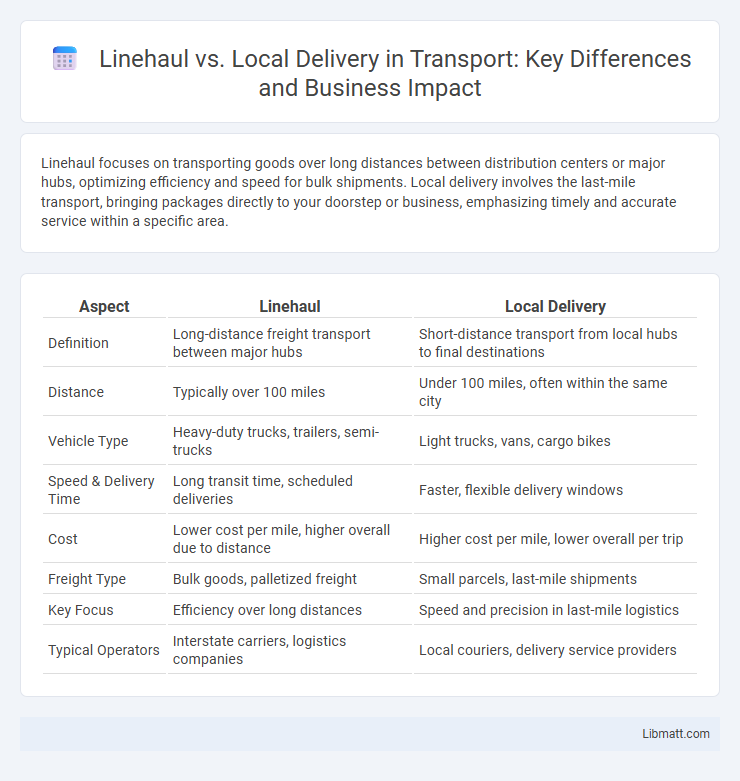Linehaul focuses on transporting goods over long distances between distribution centers or major hubs, optimizing efficiency and speed for bulk shipments. Local delivery involves the last-mile transport, bringing packages directly to your doorstep or business, emphasizing timely and accurate service within a specific area.
Table of Comparison
| Aspect | Linehaul | Local Delivery |
|---|---|---|
| Definition | Long-distance freight transport between major hubs | Short-distance transport from local hubs to final destinations |
| Distance | Typically over 100 miles | Under 100 miles, often within the same city |
| Vehicle Type | Heavy-duty trucks, trailers, semi-trucks | Light trucks, vans, cargo bikes |
| Speed & Delivery Time | Long transit time, scheduled deliveries | Faster, flexible delivery windows |
| Cost | Lower cost per mile, higher overall due to distance | Higher cost per mile, lower overall per trip |
| Freight Type | Bulk goods, palletized freight | Small parcels, last-mile shipments |
| Key Focus | Efficiency over long distances | Speed and precision in last-mile logistics |
| Typical Operators | Interstate carriers, logistics companies | Local couriers, delivery service providers |
Introduction to Linehaul and Local Delivery
Linehaul transportation involves moving goods over long distances between distribution centers or major hubs, focusing on efficiency and volume to optimize cost and transit time. Local delivery refers to the final stage of the logistics process, where packages are transported from a local depot to the end customer, emphasizing speed and accuracy. Both play crucial roles in supply chain management, with linehaul ensuring regional or national distribution and local delivery providing last-mile service.
Key Differences Between Linehaul and Local Delivery
Linehaul transportation involves moving large shipments over long distances between distribution centers or hubs, focusing on efficiency and bulk cargo handling. Local delivery covers the last mile, transporting goods from regional warehouses directly to customers or retail locations, emphasizing speed and customer service. Your choice depends on factors like shipment size, delivery speed, and geographic reach to optimize supply chain operations.
Understanding Linehaul Operations
Linehaul operations involve the long-distance transportation of goods between regional hubs, focusing on efficient consolidation and movement of large freight volumes via trucks, rail, or air. These operations are critical for connecting supply chain nodes, optimizing route planning, and reducing transit times across metropolitan areas and states. Effective linehaul management ensures timely delivery to local distribution centers, where last-mile delivery services complete the distribution process.
Exploring Local Delivery Processes
Local delivery processes optimize last-mile logistics by focusing on speed, accuracy, and customer convenience within a concentrated geographic area. Efficient local delivery relies on real-time tracking, route optimization, and personalized service to meet immediate customer demands while reducing transportation costs. You can improve overall supply chain performance by integrating advanced technologies and agile workflows tailored specifically to local routes.
Advantages of Linehaul Transportation
Linehaul transportation offers significant advantages such as longer distance efficiency, reduced transit times, and lower per-mile costs compared to local delivery. It enables your goods to move quickly between major distribution hubs, optimizing supply chain operations and minimizing handling delays. Utilizing linehaul services ensures reliable bulk freight movement, improving overall logistics scalability and cost-effectiveness.
Benefits of Local Delivery Services
Local delivery services offer faster shipping times and greater flexibility compared to linehaul transportation, ensuring Your orders reach customers promptly. These services provide enhanced tracking and personalized customer interactions, which improve overall satisfaction and retention. By focusing on short-distance routes, local delivery reduces transportation costs and minimizes carbon emissions, contributing to more sustainable logistics.
Common Challenges in Linehaul vs Local Delivery
Linehaul delivery faces challenges like route optimization over long distances, managing driver hours of service, and ensuring timely transfers between hubs. Local delivery struggles with last-mile inefficiencies, traffic congestion, and frequent stops that increase delivery times and costs. Understanding these differences helps you tailor logistics strategies to improve efficiency and customer satisfaction.
Cost Comparisons: Linehaul vs Local Delivery
Linehaul delivery typically incurs lower costs per mile due to long-distance, high-volume shipments, benefiting from economies of scale and optimized freight routes. Local delivery often involves higher expenses per stop because of frequent stops, shorter distances, and labor-intensive last-mile services. Understanding these cost differences helps you allocate your budget efficiently between linehaul and local delivery operations.
When to Choose Linehaul Over Local Delivery
Linehaul is preferred over local delivery when transporting large volumes of goods over long distances between distribution centers or major hubs, optimizing cost efficiency and transit speed. It suits businesses requiring consolidation of freight for regional or national coverage, minimizing multiple handling points and reducing overall transportation costs. Selecting linehaul is ideal when delivery timelines are less flexible but demand reliable, bulk movement across extensive geographic areas.
Future Trends in Freight Delivery Services
Linehaul freight delivery increasingly integrates autonomous vehicles and electric trucks to enhance efficiency and reduce emissions across long distances. Local delivery emphasizes micro-fulfillment centers and drone technology to facilitate rapid, last-mile service within urban areas. Data analytics and AI-driven route optimization drive both sectors towards improved sustainability and real-time responsiveness.
linehaul vs local delivery Infographic

 libmatt.com
libmatt.com